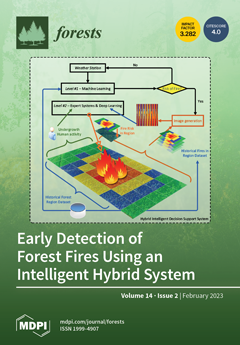Indonesia has around 4000 wood species, and 10% (400) of species are categorized as commercial wood. One species is kayu kuku (
Pericopsis mooniana Thwaites), native to Southeast Sulawesi. This species is considered a fancy wood used for sawn timber, veneer, plywood, carving,
[...] Read more.
Indonesia has around 4000 wood species, and 10% (400) of species are categorized as commercial wood. One species is kayu kuku (
Pericopsis mooniana Thwaites), native to Southeast Sulawesi. This species is considered a fancy wood used for sawn timber, veneer, plywood, carving, and furniture. The high demand for wood caused excessive logging and threatened its sustainability. In addition, planting
P. mooniana has presented several challenges, including seedling production, viability and germination rate, nursery technology, and silviculture techniques. As a result, the genera of
Pericopsis, including
P. elata (Europe),
P. mooniana (Sri Lanka), and
P. angolenses (Africa), have been listed in the Convention on International Trade in Endangered Species (CITES) Appendix. Based on The International Union for Conservation of Nature (IUCN) Red List of Threatened Species,
P. mooniana is categorized as Vulnerable (A1cd). This conservation status has raised issues regarding its biodiversity, conservation, and sustainability in the near future. This paper aims to review the conservation of potential and endangered species of
P. mooniana and highlight some efforts for its species conservation and sustainable use in Indonesia. The method used is a systematic literature review based on
P. mooniana’s publication derived from various reputable journal sources and additional literature sources. The results revealed that the future demand for
P. mooniana still increases significantly due to its excellent wood characteristics. This high demand should be balanced with both silviculture techniques and conservation efforts. The silviculture of
P. mooniana has been improved through seed storage technology, improved viability and germination rates, proper micro and macro propagation, applying hormones, in vitro seed storage, improved nursery technology, and harvesting techniques.
P. mooniana conservation can be conducted with both in situ and ex situ conservation efforts. In situ conservation is carried out by protecting its mother trees in natural conditions (i.e., Lamedae Nature Reserve) for producing good quality seeds and seedlings. Ex situ conservation is realized by planting seeds and seedlings to produce more wood through rehabilitating and restoring critical forests and lands due to its ability to adapt to marginal land and mitigate climate change. Other actions required for supporting ex situ conservation are preventing illegal logging, regeneration, conservation education, reforestation, agroforestry system applied in private and community lands, and industrial forest plantations.
Full article


